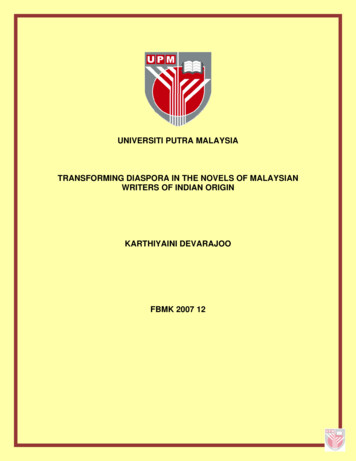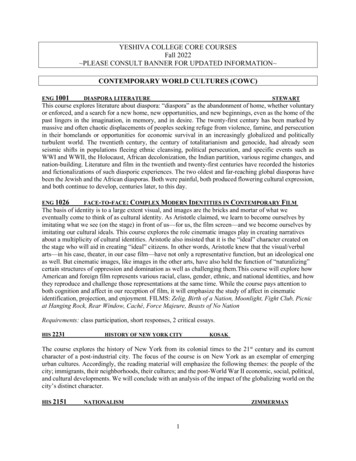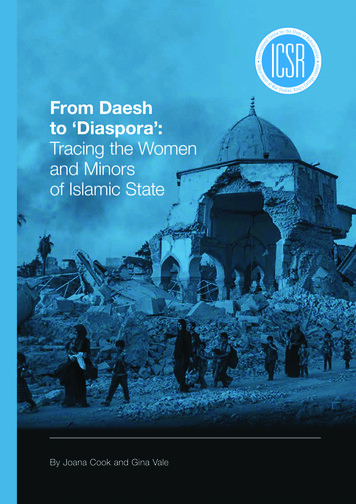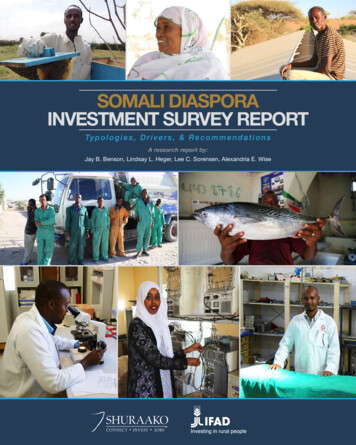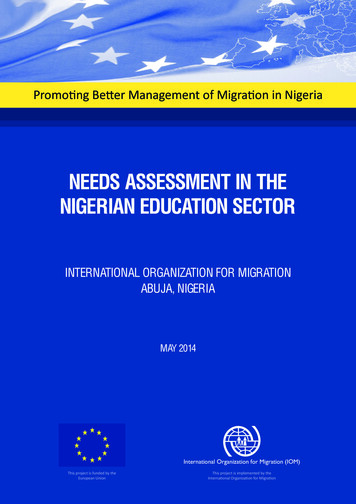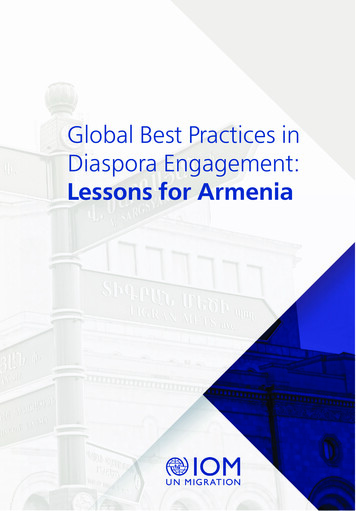
Transcription
Global Best Practices inDiaspora Engagement:Lessons for Armenia
The opinions expressed in the report are those of the authors and do not necessarily reflect the views of theInternational Organization for Migration (IOM). The designations employed and the presentation of materialthroughout the report do not imply expression of any opinion whatsoever on the part of IOM concerning the legalstatus of any country, territory, city or area, or of its authorities, or concerning its frontiers or boundaries.IOM is committed to the principle that humane and orderly migration benefits migrants and society. As anintergovernmental organization, IOM acts with its partners in the international community to: assist in meeting theoperational challenges of migration; advance understanding of migration issues; encourage social and economicdevelopment through migration; and uphold the human dignity and well-being of migrants.This publication was made possible through support provided by the IOM Development Fund within the frameworkof the “Enhancing Development through Diaspora Engagement in Armenia”. The opinions expressed herein arethose of the author and do not necessarily reflect the views of the IOM Development Fund.Publisher:International Organization for Migration, Mission in Armenia14 Petros Adamyan street, UN House, Yerevan 0010, ArmeniaTel: 374 10 58 56 92Fax: 374 10 54 33 65Email: IOMArmenia@iom.intWebsite: www.iom.int/countries/ArmeniaThis publication has been issued without formal editing by IOM. Lucia SAVCHICKAuthor:Layout and Cover Page: Aram URUTYANRequired citation: International Organization for Migration (IOM) 2021.Global Best Practices in Diaspora Engagement: Lessons for Armenia. IOM, Armenia.ISBN 978-92-9068-947-8 (PDF) IOM 2021Some rights reserved. This work is made available under the Creative Commons Attribution-NonCommercialNoDerivs 3.0 IGO License (CC BY-NC-ND 3.0 IGO).*For further specifications please see the Copyright and Terms of Use.This publication should not be used, published or redistributed for purposes primarily intended for or directedtowards commercial advantage or monetary compensation, with the exception of educational purpose e.g. to beincluded in textbooks.Permissions:Requests for commercial use or further rights and licensing should be submitted topublications@iom.int.* igo/legalcodePUB2021/034/R
Global Best Practices inDiaspora Engagement:Lessons for ArmeniaMarch, 2020
Table of ContentsIntroductionvBackgroundviThe Armenian Context1Developing Intent:A Mutually Beneficial Relationship2Modalities of AchievingState Goals through Diaspora3Selected Case Studies7Common Elements of Successful Projects13In Conclusion15References16iii
IntroductionGovernments around the world increasingly see their diasporas not as “lost talent”, but asestablished assets. Notable success stories facilitating establishment of new sectors, emergencyaid relief, academic partnerships and others are explored in this brief, extracting best practicesand conditions for success in each.This brief first tackles background of the issue, and then addresses the common policies andapproaches employed by countries globally, and asks authorities to define concreteobjectives in terms of expectations of the diaspora, and to consider the motivations and needsof the diaspora itself when considering and evaluating the effectiveness of a proposedinitiative. It provides examples first of approaches identified by extensive literature and studyof global diaspora engagement and demonstrates the forms which these approaches maytake. Following a broad global analysis, it then moves to extract examples from other countrieswhich may be of use in formulating a diaspora strategy for the Republic of Armenia.v
BackgroundTwo major shifts dominate discussions around development policies targetingdiaspora: the opportunities afforded by the globalization of talent and knowledge networks,and the movement of these policies from being seen as purely the realm of developing States.Early diaspora engagement strategies focused on enticing emigrants home, believingphysical return to be the only way to regain human capital. The first large-scale programmesfrom international organizations such as TOKTEN and MIDA focus on short-term, temporary,or virtual returns.1 Increasingly, policymakers and scholars draw their focus to embracing themultiple identities of diasporas, reconceptualizing “brain drain” as “brain circulation” inrecognition of a mutually beneficial relationship. The People’s Republic of China, for example,shifted in 1990 from a “return and serve” model to a “serve” model, no longer seeing physicalpresence as a barrier to contributions (Biao, 2005). Mexico, Morocco and the Philippinesalso see the permanent or semi-permanent stay of labour abroad as economically valuable(Ragazzi, 2014, p. 76).Diaspora outreach policies vary widely from country to country, as each as their own prioritycontributions from overseas populations. Some States may facilitate work arrangements fornationals abroad to alleviate domestic job markets (Philippines), others court investments andbusiness linkages (India), while others seek the circulation of knowledge and skills gainedabroad. Globally, diaspora mobilization projects have evolved away from philanthropic,one-sided initiatives towards collaborative partnerships with mutual benefit at their core(Larner, 2007, p. 335). Engagement should therefore be viewed through the lens ofcollaborative, inclusive partnerships wherever possible.1TOKTEN – Transfer of Knowledge Through Expatriate Nationals (UNDP initiated, now under UNV);MIDA – Migration for Development in Africa (IOM); RQN – Return of Qualified Nationals, IOM.vi
The Armenian ContextA long arc of the diaspora dispersal complicates development models focused aroundpopulations that may be better described as expatriate – those born in the country of originand not their descendants per se. For this purpose, diaspora is understood as persons holdingreal or imagined connections to Armenia. Tangible connections may be economic,citizenship-based, rooted in property or familial ties, or intangible such as a cultural or ethniclinks.In evaluating the diversity of diaspora policy options for Armenia, one must note thesignificant breadth of diaspora situated abroad as second, third or fourth-generationdescendants of migrants. While these groups are often thought to have more economicstability, relatively higher levels of education and more resources to contribute, the populationof recent emigrants including those in the near abroad should not be overlooked as agents ofdevelopment.A study interviewing various diaspora communities in the United States of America founddiaspora Armenians to have a significantly lower interest in contributing to FDI in their countryof ancestry. Contrasted with diasporas in Cuba, the Islamic Republic of Iran, and the PalestinianTerritories, Armenians interviewed were found to belong to the “old” diaspora, with fewerties and affinities to contemporary Armenia (Gillespie, 1999). Evidence suggests neweremigrants are more willing to take risks and have higher stakes in contributing to their countryof origin. This is not to say the old diaspora are not worth pursuing in engagement strategies,but there should be a separation as the motivations and expectations from each group (newand old) will likely differ.Global Best Practices in Diaspora Engagement: Lessons for Armenia1
Developing Intent:A Mutually Beneficial RelationshipWhether navigating a broad strategy, a targeted policy or a specific programme, States mustfirst settle upon their intentions for engagement–and crucially–what they are able to provide inreturn. As the Government of Armenia seeks to strengthen the pan-Armenian identity, facilitatereturn of expatriates and diaspora, and tap into the development potential of this population,it should consider the benefits and incentives it can offer in return. Below, some commonmotivations and their modalities for consideration in formulating a strategy are considered.There are multiple motivations for “tapping” into the potential of populations living abroad:in seeking financial aid to revive a sluggish economy; courting donations and encouragingphilanthropy; extracting knowledge and skills obtained overseas; stimulating tourism anddeveloping a country’s “brand”; forging links in the private sector; engaging in informaldiplomacy and building coalitions. While these examples provide ample opportunities foradvancing the goals of the State, significant personal, professional and economic advantagesare presented to the diaspora as well.Along another vein, States may also seek to “embrace” or bring in those who havenot maintained strong connections to their ancestral nation. These community-buildingapproaches move to bring closer “the lost” and unengaged. Means of doing so are typicallythrough cultural initiatives (such as community centres and events, festivals), and may beideological or religious in nature, or may speak to patriotism of diasporas. They work toconsolidate and strengthen a common identity and communality. Concretely, these types ofinitiatives can include identity cards or special status for diaspora members, (such as OCI, andOFW in Philippines) extending voting rights, representation, dual citizenship, or even welfareassistance.Both “tapping” and ”embracing” postures have merits, and many States use a combinationof these.2 Each should be reviewed and approached with some caution. Strategies which seekto tap into potential must avoid a one-sided, purely philanthropic relationship, instead workingtoward mutual benefit for diasporas and State. Strategies which embrace those who maybe born abroad as second or third-generation diaspora have potential (in some cases) to bemisconstrued as overreach by the government. This owes to the fact that embracing strategiesextend borders virtually and physically, offering both rights and obligations to a State of whichthe person is not a citizen.2A third category is often referenced here in Diaspora literature, that of “Governmentality” introduced by AlexandraDelano and Alan Gamlen. However, as it is largely theoretical in nature, we consider it out of the scope of this brief.2Global Best Practices in Diaspora Engagement: Lessons for Armenia
Modalities of Achieving State Goalsthrough DiasporaAs described in Box 1, diaspora initiatives can contribute to a number of policy objectivesaligned with country needs and strategies. These may involve financial capital, human capital,social capital and other contributions. These objectives and examples of their use areelaborated upon in more detail in the sections below.Box 1: Policy ObjectivesCommon policy objectivesuCapturing diaspora talent and skills (human capital);uAttracting short-term targeted capital inflows;uFostering long-term investment through partnerships;uDeveloping capacity (institutional and industrial);uCultivating community identity;uInformal diplomacy;uDeveloping tourism and other “nostalgia” industries(See Aguinas and Newland, 2012; Naujoks, 2013; Delano and Gamlen, 2014)Considering a broad range of literature on the nature of diaspora engagement policies andthe State, global case studies and expert reviews, we must note the existing availability ofseveral guides and handbooks to diaspora engagement available to governments. In particular,organizations such as the IOM, Migration Policy Institute, and others produce guides or“road maps” to developing and tailoring diaspora engagement strategies. This paper pullsfrom several of these guides which remain relevant today.Best practices of government-led initiatives should be taken in context of a broaderframework, encompassing research and mapping into diaspora capabilities, trust andGlobal Best Practices in Diaspora Engagement: Lessons for Armenia3
capacity-building of the diaspora, and division of responsibility among stakeholders, toname a few. At the outset of policy and project formation, Armenia must make use of firmpriorities and objectives for the direction of engagement. These objectives should serve as thefoundation of diaspora engagement policy. Many categories presented below intersect withone another and should not be considered an exhaustive menu of policy options.4Global Best Practices in Diaspora Engagement: Lessons for Armenia
Table 1:Diaspora Initiative Typologies, Examples and CharacteristicsObjectiveKnowledge andSkills Key CharacteristicsProfessional networksSkills-matching databasesCoachingVirtual return for education ortraining purposes (distancelearning)§ Pro bono capacity-building ofindividual initiatives§ Partnerships with private sectorfor return or training schemes§ Providing support to universities§ Includes competitive, desirable oppor- Taiwan Province of§ Direct commercial enterprisetunities for professional engagementthe People's Republic§ Identifies existing skills in the diaspora of China§ Fills knowledge/skills gaps in country Republic of Korea§§§§of originInvests in long-term development ofhuman capitalNetworks and programmes can be broad,based by sector, locale, or institutionGovernment can act as steward and“matchmaker”Largely diaspora-drivenScotlandNew ZealandColombiaChinaSouth AfricaIndia§ Short-term infusions of capital andSenegal§§§§§investmentRemittancesDiaspora bondsFDIOpening new areasCreating business expansionopportunitieslong-term investment§ Mitigates risk through knowledgeof local language, culture, andinstitutions§ Uses knowledge and position ofdiaspora to expand opportunities andenterprisesTaiwan Province ofthe People's Republicof China§§§§Hometown associationsFoundationsOnline platforms (e.g. Kiva)Faith-based groups§ Can be an effective “entry-point” toMexico§§§§§§CommunityIdentityNotable Examplesmore substantial interactions(Kingsley Aikins)Targeted to specific sectors orgeographic locationsOften used during or post-crisissituations to mobilize funds quicklyCan be more effective and agile thannon-diaspora philanthropyGovernment facilitates by helping toidentify projects, reduce barriers toimplementationVulnerable to differing priorities inCOO and within diasporaRequire concrete, targeted objectivesfor successRepublic of ippinesIndia§ Cultural centres§ University groups and§ Provide networks for people to engage Bangladesh§ Can be facilitated by embassies/ con- Irelandassociations§ Informal networks via Facebookor WhatsApp groups§ Festivals, holiday celebrationsand conferencessulates or diaspora-driven§ Offer support to other diasporas andcontribute to welfare of community§ Maintain cultural linkagesGlobal Best Practices in Diaspora Engagement: Lessons for ArmeniaFranceUnited Kingdom5
ObjectiveInvolvementTourism andHeritage,NostalgiaIndustries§§§§Key CharacteristicsRoots tourismFriends and family tourismTrade in nostalgia goodsSpecialty food items§ Emotion-driven§ Incentivizes diaspora to visit to§§§§Notable ExamplesIndiaIrelandreconnect with roots, in turnPolandstimulating the industry andcommerceIsraelHomecoming trips may includeHaitivolunteering aspects or homestaysto better understand life in countryTrips from diaspora to visit family orfriends in COOOffers low-cost entry point for friendsof diaspora to experience the countrySpending is often concentrated incommunities and local economies,rather than tour operatorsSource: Author’s compilation, adapted from Kuznetsov, Naujoks, Delano and Gamlen, Aquinas and Newland.6Global Best Practices in Diaspora Engagement: Lessons for Armenia
Selected Case StudiesBuilding off the menu of options addressed in the previous section, and inconsideration of the strengths of the diaspora, the following cases are chosen for furtherconsideration in adaptation to the Armenian context. First, we look at knowledge and skillstransfer as demonstrated by the Indian diaspora in Silicon Valley. Second, foreign directinvestment as demonstrated by Chinese diasporas, and finally, the adaptation of hometownassociations evidenced by Mexico’s 3x1 program.Knowledge and Skills TransferConditions for success and best practices:mutually beneficial opportunities for bothparties; willingness to provide long-termcoaching and support; adaptable and agileregulatory environment; active businesssupport and investment from diaspora;Initiative for coaching and mentorship;favourable government policies; gaps in homeeducational and vocational training systems areidentified and deficiencies in home systemsameliorated.Relevance for Armenia: India presents a compelling case for study to the Armenian contextfor several reasons. Like Armenia, it has a large, widely dispersed diaspora who may beestablished, educated and relatively affluent in industrialized countries. Like diasporaArmenians, persons of Indian origin (PIOs) have strong connections to the tech andengineering sectors in notoriously successful concentrations of innovation such as SiliconValley. India also has a diverse migration history, with multiple waves over several centuriesresulting in multiple generations who do not know the culture, languages, or institutions, andmay have little affinity or real connection to the country. In fact, several case studies comparethe successes in knowledge transfer of the Indian diaspora against that of Armenia(See Kuznetsov, 2006, p. 16).Context: The Indian information technology and software boom throughout the 70s and 80sis a well-documented case study, with many States attempting to replicate its success. Notlimited to the IT sector, Indian diaspora have also made significant efforts to alignthe medical and engineering fields back home to international standards. With manyfirst-generation Indians attending schools in the United States for post-graduate study, asignificant number remain to rise through the ranks of their respective careers after graduation.Global Best Practices in Diaspora Engagement: Lessons for Armenia7
This has helped to form a highly educated diaspora with strong connections to the countryof origin. However, there has been significant cross-pollination with established emigrantcommunities and new expats:In the early 1980s, several small Indian companies came to Silicon Valley insearch of low-end contract work in software development. Severalexecutives of Indian origin were willing to help, but most found the Indiancompanies’ work to be unsatisfactory and their development tools andcomputers inadequate Indian companies could not meet, or sometimeseven understand, United States' standards for quality and timeliness(Abhishek et. al, 2006, p. 80).At this stage, executives and IT experts in the diaspora worked with newcomers on an ad hocbasis to work through imbalances in performance and quality standards. Indian diaspora roseto the top of IT companies and began lobbying their companies to consider movingoperations and research and development to India.While the massive growth in India’s software and IT economy that followed also involvedsignificant assistance from “first mover” investors, the capacity development provided byknowledge and skills transfer early in the cycle was instrumental in coaching the industry toits position on the global market. A number of situational factors precipitated the rise (indeed,similar to those found in many similar case studies) including an increased cost to conductingbusiness in the United States, and an improvement in the attractiveness of the Indian economyand workforce (Abhishek et. al, 2006).The following years saw the ripple effects of the extensive coaching and mentorship ofdiaspora to the nascent IT sector in India. Top companies opened branches in India (such asGE, IBM), investment began to flow, and many diasporas moved themselves to India to starttheir own firms and enterprises. Professional associations within diaspora communities abroadstrengthened to maintain connectivity and the cycle of mentorship.Lessons for Armenia: With Armenia’s competitive advantage in its similar positioningin Silicon Valley start-ups and engineering companies, the high proliferation of math andscience workers, and the nascent IT industry in Armenia itself, this is a case worth furtherinvestigation.Early attempts at investing in the IT sector in India by diaspora fell through or wereabandoned due to unfavourable regulatory conditions and poor capacity of domestic workers.Armenia also faces barriers in producing and training a workforce to keep up withknowledge-intensive industries. While (as in India) diaspora have helped to establisheducational institutions in country, education abroad remains more desirable. Armenia shouldwork with diaspora leaders in their fields to identify barriers to development of their sectors.8Global Best Practices in Diaspora Engagement: Lessons for Armenia
Financing, Entrepreneurship and InvestmentConditions for success and best practices:experience in a highly successful incubatorenvironment (such as Silicon Valley) andforeign education; sector identification bygovernment followed by action from diaspora;availability and strength of a free-market; seedfunding; matching contributions; coaching andmentorship from “first mover” diasporas to notonly encourage but convince countries of origininvestors of new opportunities; desire andwillingness to relocate; assistance in relocationand business development, quality andstrength of home country institutions andorganizationsRelevance for Armenia: Like Taiwan Province of the People's Republic of China , Armeniahas experienced a large outflow of knowledge workers and talent to more profitableendeavours abroad. Similar to the above example in knowledge and skills transfer, theseestablished elites can play pivotal roles in bringing new financial concepts and enterprises totheir country of origin. As the government seeks to attract these individuals to“repatriate” themselves and their capital to Armenia, the mentioned example of a “virtuouscycle” outlined by Saxenian and Kuznetsov provide a compelling example.Context: Contrary to many other diaspora success stories, the mentioned example is oftendescribed as one first initiated and identified by the government, rather than a “piggy-back”venture on existing diaspora partnerships. As with the Indian diaspora, the people from TaiwanProvince of the People's Republic of China community in California had achieved success bytaking advantage of higher education in Western countries and subsequent job opportunitiesin their sectors.Figure 1:The "Virtuous Cycle" of Knowledge Workers and ReturneesWhen the Taiwan Province of the People's Republic of China decided topromote venture capital industry in the 1980s, it had neither the capabilities,nor a blueprint to do so. Many were opposed to the idea because the conceptGlobal Best Practices in Diaspora Engagement: Lessons for Armenia9
of venture capital was foreign to traditional practice of Taiwan Province of thePeople's Republic of China Through a process of intense interactions withthe Chinese Diaspora in Silicon Valley, new institutions such as Seed Fund(with an initial allocation of NT 800 million, later complemented by anadditional 1.6 billion) provided matching capital contributions to privateventure capital funds (Kuznetsov, 2008, p. 206).The successful import of venture capitalism (VC) to Taiwan Province of the People's Republicof China was facilitated by several factors. First, it relied on the improving regulatory andbusiness environment in Taiwan Province of the People's Republic of China. Diaspora beganto see the opportunities available in beginning enterprises in their home countries and werepre-disposed to return. The identification and engagement of key stakeholders in the venturecapital space by government led to the creation of venture funds in Taiwan Province of thePeople's Republic of China by diaspora. These overseas educated Chinese were invited torelocate to Taiwan Province of the People's Republic of China, and as they establishedsuccessful ventures, used their networks to coax more investors to do the same. Institutionsand seed capital sprung up to meet and support new businesses.Lessons for Armenia: To recreate a virtuous cycle and emulate the “demonstration effect”,government should broadcast widely to diaspora in key areas the reforms made and newopportunities for them in Armenia. Rather than focusing on “old” diaspora, who show lessaffinity for return, those in the near abroad such as the Russian Federation may be better suitedto these return and investment initiatives, as they are more likely to speak the language, knowthe local context, and have a higher propensity for relocation.Philanthropy and Hometown AssociationsConditions for success and best practices:Public-private partnership with emphasis ondiaspora-led programming; heavy involvementof both diaspora and of the State, requiringresources and time investments from bothparties;local buy-in for sustainability ofinitiatives, involvement and courtship of theprivate sector in matching funds; oversight andadvice by independent actors (not investedemotionally) to align initiatives to nationalstrategies and developmental priorities.Relevance for Armenia: Given the high population of Armenians resident abroadengaged in circular migration and the considerable amounts remitted by emigrants, acomparison without the Mexican and South American cases would be incomplete. Whilemargins for circular migrants to the Russian Federation are slim and the majority of remittancesgo towards household costs and consumables, hometown associations (or HTAs) can servemany purposes well suited to Armenia’s needs, including building and strengthening commonidentity among diaspora and a pan-Armenian cause.In addition, a parallel approach to HTAs might be implemented with older diasporas such asthose in the United States and Western Europe. These groups belonging to the “old”diaspora have demonstrated high propensity for philanthropic activity, and often engage infundraising efforts. While old diasporas may lack a “hometown” within contemporary Armeniaor strong links to certain communities, Armenian schools, churches, NGOs and foundationsserved by the old diaspora might “adopt” hometowns and act as sponsors.10Global Best Practices in Diaspora Engagement: Lessons for Armenia
Context: Mexico maintains a steady stream of migration to the United States, oftenengaging in low-skilled labour. Centuries of migrations in this part of the world have formedstrong migrant communities and networks, including HTAs. HTAs are private groups ofmigrants collectivizing based on a common town, city or region of origin, and are foundthroughout Columbian, Venezuelan, Honduran, Filipino, Pakistani and numerous otherdiasporas as well. The associations serve many purposes and have been described asmicro-representative bodies, which in some cases can influence public policy back home. HTAsare often led by a steering committee or a board of advisors, and act as a tether betweenmigrant communities and friends and family at home, facilitating knowledge and financialflows (Orozco and Rouse, 2007).The Tres por Uno or 3x1 project in Mexico is touted as an example of harnessingremittances for targeted development purposes, while fuelling engagement and interest ofmigrant populations in current affairs of their countries of origin.The 3x1 Program incentivizes HTA contributions for community projects,referred to as collective remittances, by offering matching funds from federal,State, and municipal governments, creating a three-to-one match that givesthe program its name. Common projects include building infrastructure suchas roads, water, sewer, and electricity in migrants’ hometowns, as well aseducational, cultural, sports, and health projects (Malone and Durden, 2018,p. 141).The key element of the 3x1 project is the strong public-private collaboration betweenmigrant groups and the State, as well as the opportunity for other investors such as WesternUnion or Oxfam to match contributions. By maintaining an open line of communication,migrants put forth collective funds toward initiatives and improvements they would like to seein their hometowns, which are then implemented by local governments and implementingpartners. The decentralization of risk in donating through a collective fund, combined witha multi-stakeholder approach has drawn considerable attention to this model by othergovernments. Moreover, the project has yielded tangible results in the form of localimprovements totalling USD 1.5 billion MXN as of 2014 (Malone and Durden, 2018).Orozco outlines some core elements of projects implemented via hometown associations inthe below table:OwnershipCommunity membersparticipate in decisionmaking; communitymembers participate inimplementation; andcommunity membershave control of projectafter completion.CorrespondenceProject meets basic needs;needs met are a developmentpriority; and implementationoccurs in association orcoordination with ct enablesdevelopment goals;does not constitute aburden or entail addedcosts; and has a longlifecycle.Resources for theproject are available inother communities; andinstitutional environmentfacilitating implementation is available in othercommunities.Source: M. Orozco, 2005.Global Best Practices in Diaspora Engagement: Lessons for Armenia11
It should be noted the typical pitfalls of diaspora philanthropy certainly apply to HTAs, and ifoperationalized in the Armenian context, would require significant guidance towardproductive initiatives which match both government, local, and diaspora priorities. DiasporaArmenia’s philanthropic past should be heavily considered when selecting initiatives put forthby diaspora. As in the Filipino case of the
initiatives can include identity cards or special status for diaspora members, (such as OCI, and OFW in Philippines) extending voting rights, representation, dual citizenship, or even welfare . Best practices of government-led initiatives should be taken in context of a broader framework, encompassing research and mapping into diaspora .
